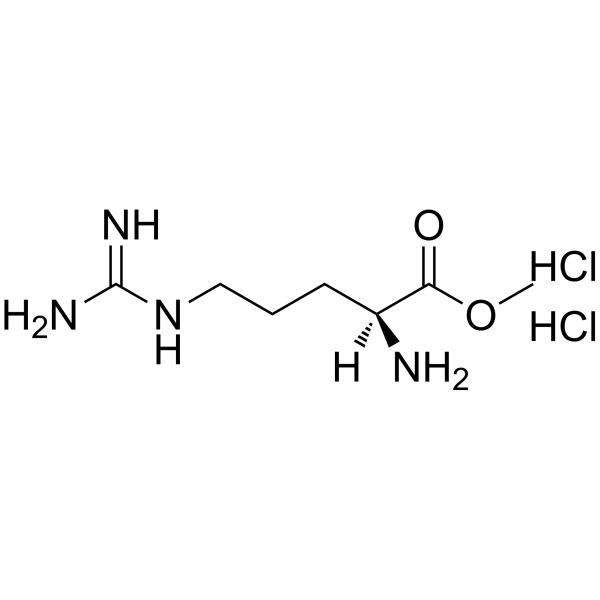H-Arg-OMe.2HCL

H-Arg-OMe.2HCL structure
|
Common Name | H-Arg-OMe.2HCL | ||
|---|---|---|---|---|
| CAS Number | 26340-89-6 | Molecular Weight | 261.149 | |
| Density | 1.31g/cm3 | Boiling Point | 329.9ºC at 760 mmHg | |
| Molecular Formula | C7H18Cl2N4O2 | Melting Point | ~190 °C (dec.) | |
| MSDS | USA | Flash Point | 153.3ºC | |
|
Enhancement of MALDI-MS spectra of C-terminal peptides by the modification of proteins via an active ester generated in situ from an oxazolone.
Anal. Chem. 78(22) , 7861-9, (2006) For selective C-terminal derivatization of peptides and proteins, we have devised a method for activating the C-terminal carboxyl group by extending the oxazolone chemistry. A mixture of formic acid and acetic anhydride was found to be effective for the forma... |
|
|
Shrimp waste extract and astaxanthin: rat alveolar macrophage, oxidative stress and inflammation.
J. Food Sci. 77(7) , H141-6, (2012) Astaxanthin is a carotenoid known to have antioxidant and antiinflammatory properties. This study examined if shrimp astaxanthin modulates the production of superoxide (O(-)(2)), nitric oxide (NO), and tumor necrosis factor-α (TNF-α) in rat alveolar macrophag... |
|
|
A proximal pair of positive charges provides the dominant ligand-binding contribution to complement-like domains from the LRP (low-density lipoprotein receptor-related protein).
Biochem. J. 443(1) , 65-73, (2012) The LRP (low-density lipoprotein receptor-related protein) can bind a wide range of structurally diverse ligands to regions composed of clusters of ~40 residue Ca2+-dependent, disulfide-rich, CRs (complement-like repeats). Whereas lysine residues from the lig... |
|
|
An engineered L-arginine sensor of Chlamydia pneumoniae enables arginine-adjustable transcription control in mammalian cells and mice.
Nucleic Acids Res. 35 , e136, (2007) For optimal compatibility with biopharmaceutical manufacturing and gene therapy, heterologous transgene control systems must be responsive to side-effect-free physiologic inducer molecules. The arginine-inducible interaction of the ArgR repressor and the ArgR... |
|
|
Calcium is involved in nitric oxide- and auxin-induced lateral root formation in rice.
Protoplasma 249(1) , 187-95, (2012) In the present study, the role of nitric oxide (NO) in the regulation of lateral root (LR) formation in rice was examined. Application of sodium nitroprusside (SNP; a NO donor) and indole-3-butyric acid (IBA; a naturally occurring auxin) to rice seedlings ind... |
|
|
A combination of ischemic preconditioning and allopurinol protects against ischemic injury through a nitric oxide-dependent mechanism.
Nitric Oxide 26(1) , 1-8, (2012) This study examined the cytoprotective mechanisms of a combination of ischemic preconditioning (IPC) and allopurinol against liver injury caused by ischemia/reperfusion (I/R). Allopurinol (50mg/kg) was intraperitoneally administered 18 and 1h before sustained... |
|
|
The anabolic effect of arginine on proteins in skin wound and muscle is independent of nitric oxide production.
Clin. Nutr. 27(4) , 649-56, (2008) L-arginine may play a role in regulation of protein metabolism. The aim of the present study was to investigate the effect of L-arginine supplementation on protein metabolism in skin wound and muscle in anesthetized rabbits.L-[ring-(13)C(6)]phenylalanine was ... |
|
|
Nebivolol decreases endothelial cell stiffness via the estrogen receptor beta: a nano-imaging study.
J. Hypertens. 27(3) , 517-26, (2009) Nebivolol (NEB) is a [beta]1-receptor blocker with nitric oxide-dependent vasodilating properties. NEB-induced nitric oxide release is mediated through the estrogen receptor.Here, we tested the hypothesis that NEB decreases endothelial cell stiffness and that... |
|
|
Modulation by salt intake of the vascular response mediated through adenosine A(2A) receptor: role of CYP epoxygenase and soluble epoxide hydrolase.
Am. J. Physiol. Regul. Integr. Comp. Physiol. 299(1) , R325-33, (2010) High-salt intake can change the effect of adenosine on arterial tone in mice. The aim of this study was to clarify the mechanism by which this occurs. Using aortas from mice fed a 4% NaCl (HS) or 0.45% NaCl (NS) diet for 4-5 wks, concentration-response curves... |
|
|
Tocolytic effect of delta9-tetrahydrocannabinol in mice model of lipopolysaccharide--induced preterm delivery: role of nitric oxide.
Reprod. Sci. 17(4) , 391-400, (2010) In this study, we explained that exogenous cannabinoid, Delta(9)-tetrahydrocannabinol (THC), has a preventive effect in a murine model of lipopolysaccharide (LPS)-induced preterm delivery and the contribution of nitric oxide (NO) pathway as a mechanism involv... |